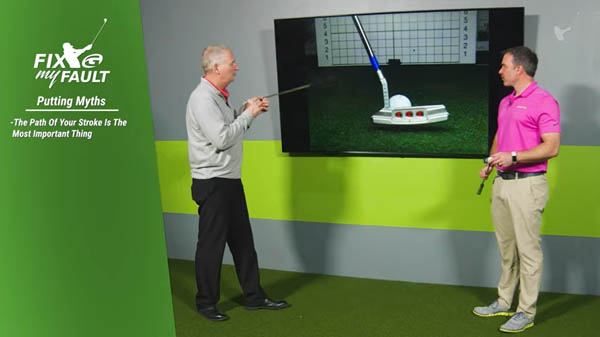Putting: Myths Vs Reality
Are You Hitting Putts Correctly Or Even Lining Up Correctly?
By Ryan Gager
Putting is a huge part of the game and one of the quickest ways to lower your scores. It takes a lot of practice, and it only helps if you practice correctly. GOLFTEC’s Nick Clearwater is joined by Kevin Weeks, Director of Instruction at Cog Hill Golf & Country Club. Kevin has worked with some of the top players in the game, and in this edition of Fix My Fault he breaks down some putting myths vs what’s reality so that you know exactly how and what to practice.
Myth #1: The Path of Your Stroke is the Most Important Thing

You hear it all the time, but probably shouldn’t. Many golfers set up tees on practice greens to align their paths. However, Kevin demonstrates that you can still make putts with a path that isn’t straight.
In his lab, Kevin used a robot to swing the putter from out to in at six degrees. What mattered is that the face of the putter was straight to the target, so even if the path was off, the putts still went in.
Instead, the reality is that 90+ percent of the initial starting direction is influenced by face angle. If you’re missing putts on either side of the hole, check your face angle instead of your overall stroke path.
Putting Practice: Work on putts from 4 to 12 feet to make sure your face angle is correct. Then move back and practice 25 to 40 feet to work on speed and eliminating 3-putts.
Myth #2: Make a Slow Backswing and Accelerate Through the Putt

A popular misconception after a missed putt is that the player decelerated the putter and it caused the miss. It’s very hard to decelerate once the putter is in motion.
Often, golfers will then try for the opposite of decelerating, which is taking the putter back slowly then quickly swinging through the ball. Kevin says the problem with accelerating so much is that it requires more energy, which causes the trail hand to squeeze the putter grip tighter, which ultimately twists and turns the club face from being square at impact.
The quick acceleration also causes inconsistent distance control because the ball is coming off the putter face too quick.
Instead, Nick recommends a “coasting speed.” This means once you have started to accelerate the putter from the backswing, don’t continue to accelerate through the ball. Let the putter head “coast” through impact.
Myth #3: Align Your Body Parallel to the Target Line

Kevin tells us that through his research, only 15 percent of players lineup with their feet, knees, hips and shoulders parallel to the target line.
Even, Jack Nicklaus, arguably the greatest putter of all time wasn’t lineup up parallel to his target line. Because everyone’s eyes view things differently, you must line up to where it’s comfortable for how you see the target line.
Putting Practice: Place four or five dots on the ground one foot apart in a straight line toward your target. Simply set up to the putt and align yourself however you need to so that the dots look straight towards the target.
Knowing these myths and understanding the misconceptions will help you be able to practice better and make more putts! As always, if your putting game is really off or you just need fine tuned be sure to stop into your local GOLFTEC for a putting lesson, where we use the EyeLine Sight Line system to help you get set up properly, see the correct line and hit better putts!
Colorado AvidGolfer Magazine is the state’s leading resource for golf and the lifestyle that surrounds it, publishing eight issues annually and proudly delivering daily content via coloradoavidgolfer.com.
Leaving Negative Thoughts Behind when You Head to the Tee Box
How does worrying impact our golf performance? What strategies can we use to manage it?
All in the Family Meal
The secret ingredient of Colorado golf course success is well-fed caddies, cooks and groundskeepers
CSU Grad Davis Bryant Discusses His Rise as a Pro Golfer
Colorado State grad Davis Bryant opens up on his path to the pros and what keeps him busy when he’s off the course


